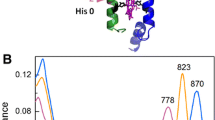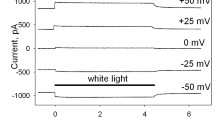Summary
Bacteriorhodopsin-mediated photopotential generation has been studied in two kinds of lipid/water systems: (1) decane solution of asolectin was used as the lipid phase; (2) a mixture of bacteriorhodopsin sheets and hexane solution of phosphatidyl choline was applied onto a water surface to form a monolayer, and then the monolayer was covered with a 0.3-mm decane layer. In both cases, illumination was found to induce formation of an electric potential difference, with the bulk water phase being found negative when measured with a vibrating electrode. In the latter, but not in the former, system small amounts of a protonophorous uncoupler were found to stimulate the photoresponse. Large amounts of the uncoupler proved depressing in both systems. Phenyldicarbaundecaborane anion (PCB−) was shown to substitute for the uncoupler, being much more potent both as an activator and as an inhibitor of the photoresponse. In both studied systems, gramicidin A inhibits the photoresponse, the effect being greatly potentiated by K+, Na+ or H+ ions.
In the system “decane solution of asolectin/water,” an Ag/AgCl electrode immersed into the lipid phase can be used instead of a vibrating electrode. All the measured features of the photoelectric responses observed with any of these electrodes were found to be quite similar to those inherent in a phospholipid-impregnated collodion film adsorbing bacteriorhodopsin sheets on one of its surfaces.
A scheme is discussed built on the assumption that photopotentials in all the studied systems are due to an uphill light-dependent transport of H+ ions from the bulk water phase to a water cavity localized between a bacteriorhodopsin sheet and the surface of the bulk lipid phase. Thus, the above lipid/water systems containing bacteriorhodopsin are composed of four, rather than two, phases, as was supposed previously.
Bacteriorhodopsin-mediated photopotential generation has been studied also in the decane/water system without phospholipids. This system with bacteriorhodopsin sheets added to the water phase demonstrates a light-dependent photoelectric response reaching 1.5 V, which can be measured only by a vibrating electrode. The photoresponse starts after a lag period of several seconds. Switching off the light results in the reversal of the light-induced electric potential change. The off-effect also has a lag period. The action spectrum of the photoresponse shows at least two maxima: a smaller at 560 nm and a larger at <420 nm. Free retinal can substitute for bacteriorhodopsin in the studied system. All the above effects disappear if, instead of air, argon is used. In the system “decane solution of asolectin/water,” a slow photoelectric response of this type can be demonstrated at neutral pH in the presence of gramicidin and at pH 4 without gramicidin. A suggestion is put forward that the slow photoelectric response is due to an interface Volta-potential change induced by a product of photooxidation of bacteriorhodopsin and/or free retinal released from bacteriorhodopsin.
Similar content being viewed by others
References
Babakov, A.V., Mjachikov, I.V., Sotnikov, P.E., Terechov, O.P. 1972. Automatic device for measuring of potential on monolayers.Zhurnal Fiz. Khim. 7:1873–1876
Blaurock, A.E., Stoeckenius, W. 1971. Structure of the purple membrane.Nature New Biol. 233:152–154
Boguslavsky, L.I., Boytsov, V.G., Volkov, A.G., Kozlov, I.A., Metelsky, S.T. 1976. Light-dependent translocation of H+ from water to octane by bacteriorhodopsin.Bioorganicheskaya Khimi. 2:1125–1130
Boytsov, V.G., Boguslavsky, L.I. 1966. Automatic device for measuring of Volta-potential on semiconductor.Electrokhimiya 2:377–379
Dawson, R.M.C. 1963. On the mechanism of action of phospholipase A.Biochem. J. 88:414–425
Drachev, L.A., Frolov, V.N., Kaulen, A.D., Liberman, E.A., Ostroumov, S.A., Plakunova, V.G., Semenov, A.Yu., Skulachev, V.P. 1976. The reconstitution of biological molecular generators of electric current: Bacteriorhodopsin.J. Biol. Chem. 251:7059–7065
Drachev, L.A., Jasaitis, A.A., Kaulen, A.D., Kondrashin, A.A., Liberman, E.A., Nemeček, I.B., Ostroumov, S.A., Semenov, A.Yu., Skulachev, V.P. 1974a. Direct measurement of electric current generation by cytochrome oxidase, H+-ATPase and bacteriorhodopsin.Nature (London) 249:321–324
Drachev, L.A., Kaulen, A.D., Kondrashin, A.A., Liberman, E.A., Nemeček, I.B., Ostroumov, S.A., Semenov, A.Yu., Skulachev, V.P., Jasaitis, A.A. 1974b. Electric current generation by cytochrome oxidase, H+-ATPase and bacteriorhodopsin.Dokl. Acad. Nauk. SSSR 218:481–484
Drachev, L.A., Kaulen, A.D., Ostroumov, S.A., Skulachev, V.P. 1974c. Electrogenesis by bacteriorhodopsin incorporated in a planar phospholipid membrane.FEBS Lett. 39:43–45
Drachev, L.A., Kaulen, A.D., Skulachev, V.P. 1977. Temporal characteristics of bacteriorhodopsin as a molecular biological generator of electric current.Mol. Biol. USSR 11:1377–1387
Drachev, L.A., Kaulen, A.D., Skulachev, V.P. 1978. The resolution of the intermediate steps in the bacteriorhodopsin-linked electrogenesis.FEBS Lett. 87:161–167
Hwang, S., Korenbrot, J.I., Stoeckenius, W. 1977a. Structural and spectroscopic characteristics of bacteriorhodopsin in air-water interface films.J. Membrane Biol. 36:115–135
Hwang, S., Korenbrot, J.I., Stoeckenius, W. 1977b. Proton transport by bacteriorhodopsin through an interface film.J. Membrane Biol. 36:137–158
Kayushin, L.P., Skulachev, V.P. 1974. Bacteriorhodopsin as an electrogenic proton pump: Reconstitution of bacteriorhodopsin proteoliposomes generating Δψ and ΔpH.FEBS Lett. 39:39–42
Mathies, R., Stryer, L. 1976. Retinal has a highly dipolar vertically excited singlet state. Implication for vision.Proc. Natl. Acad. Sci. USA 73:2169–2173
Oesterhelt, D., Stoeckenius, W. 1971. Rhodopsin-like protein from the purple membrane ofHalobacterium halobium.Nature New Biol. 233:149–152
Oesterhelt, D., Stoeckenius, W. 1973. Functions of a new photoreceptor membrane.Proc. Natl. Acad. Sci. USA 70:2853–2857
Oesterhelt, D., Stoeckenius, W. 1974. Isolation of the cell membrane ofHalobacterium halobium and its fractionation into red and purple membrane.Methods Enzymol. 31:667–678
Ovchinnikov, Yu.A., Ivanov, V.T., Shkrob, A.M. 1974. Membranoactive Complexones. Elsevier, Amsterdam
Racker, E., Stoeckenius, W. 1974. Reconstitution of purple membrane vesicles catalyzing light-driven proton uptake and adenosine triphosphate formation.J. Biol. Chem. 249:662–663
Voytsitsky, V.M., Drachev, L.A., Kaulen, A.D., Skulachev, V.P. 1979a. The photoelectrical responses of bacteriorhodopsin in lipid-water systems.Dok. Acad. Neuk. SSSR 245:726–729
Voytsitsky, V.M., Drachev, L.A., Kaulen, A.D., Skulachev, V.P. 1979b. Bacteriorhodopsin photoelectric responses in lipid/water systems.Bioorganicheskaya Khimi. 5:1184–1195
Author information
Authors and Affiliations
Rights and permissions
About this article
Cite this article
Drachev, L.A., Kaulen, A.D., Skulachev, V.P. et al. Bacteriorhodopsin-mediated photoelectric responses in lipid/water systems. J. Membrain Biol. 65, 1–12 (1982). https://doi.org/10.1007/BF01870463
Received:
Issue Date:
DOI: https://doi.org/10.1007/BF01870463




